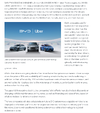- Joined
- 3 July 2009
- Posts
- 28,314
- Reactions
- 25,656
Yes I think a dual cab ev with a range extender would be a hit here. We like the EV, but would like the flexibility of a range extended.
They are just starting to come out, but I think in a few years time, things will be completely different IMO
They are just starting to come out, but I think in a few years time, things will be completely different IMO


